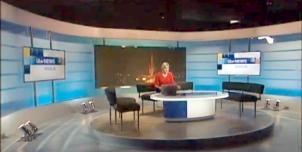Full Freeview on the Sandy Heath (Central Bedfordshire, England) transmitter
| Google Streetview | Google map | Bing map | Google Earth | 52.130,-0.242 or 52°7'47"N 0°14'33"W | SG19 2NH |
The symbol shows the location of the Sandy Heath (Central Bedfordshire, England) transmitter which serves 920,000 homes. The bright green areas shown where the signal from this transmitter is strong, dark green areas are poorer signals. Those parts shown in yellow may have interference on the same frequency from other masts.
This transmitter has no current reported problems
The BBC and Digital UK report there are no faults or engineering work on the Sandy Heath (Central Bedfordshire, England) transmitter._______
Digital television services are broadcast on a multiplexes (or Mux) where many stations occupy a single broadcast frequency, as shown below.
64QAM 8K 3/4 27.1Mb/s DVB-T MPEG2
H/V: aerial position (horizontal or vertical)
Which Freeview channels does the Sandy Heath transmitter broadcast?
If you have any kind of Freeview fault, follow this Freeview reset procedure first.Digital television services are broadcast on a multiplexes (or Mux) where many stations occupy a single broadcast frequency, as shown below.
64QAM 8K 3/4 27.1Mb/s DVB-T MPEG2
H/V: aerial position (horizontal or vertical)
Which BBC and ITV regional news can I watch from the Sandy Heath transmitter?

BBC Look East (West) 1.0m homes 3.7%
from Cambridge CB4 0WZ, 29km east-northeast (65°)
to BBC Cambridge region - 4 masts.
70% of BBC East (East) and BBC East (West) is shared output

ITV Anglia News 1.0m homes 3.7%
from Norwich NR1 3JG, 119km east-northeast (60°)
to ITV Anglia (West) region - 5 masts.
All of lunch, weekend and 80% evening news is shared with Anglia (East)
How will the Sandy Heath (Central Bedfordshire, England) transmission frequencies change over time?
| 1965-80s | 1984-97 | 1997-98 | 1998-2011 | 2011-13 | 12 Feb 2020 | ||||
| VHF | A K T | K T | K T | W T | W T | ||||
| C6 | ITVwaves | ||||||||
| C21 | C4waves | C4waves | C4waves | +BBCB | BBCB | ||||
| C24 | ITVwaves | ITVwaves | ITVwaves | D3+4 | D3+4 | ||||
| C27 | BBC2waves | BBC2waves | BBC2waves | BBCA | BBCA | ||||
| C31 | BBC1waves | BBC1waves | BBC1waves | ||||||
| C32 | com7 | ||||||||
| C33 | SDN | ||||||||
| C34 | com8 | ||||||||
| C35 | _local | ||||||||
| C36 | ArqA | ||||||||
| C39 | C5waves | C5waves | |||||||
| C43 | _local | ||||||||
| C48 | ArqB | ArqB | |||||||
| C51tv_off | SDN | ||||||||
| C52tv_off | ArqA | ||||||||
| C55tv_off | com7tv_off | ||||||||
| C56tv_off | COM8tv_off |
tv_off Being removed from Freeview (for 5G use) after November 2020 / June 2022 - more
Table shows multiplexes names see this article;
green background for transmission frequencies
Notes: + and - denote 166kHz offset; aerial group are shown as A B C/D E K W T
waves denotes analogue; digital switchover was 30 Mar 11 and 13 Apr 11.
How do the old analogue and currrent digital signal levels compare?
| Analogue 1-4 | 1000kW | |
| BBCA, D3+4, BBCB | (-7.4dB) 180kW | |
| SDN, ARQA, ARQB | (-7.7dB) 170kW | |
| com7 | (-13dB) 49.6kW | |
| com8 | (-13.1dB) 49.1kW | |
| Mux 1*, Mux 2*, Mux A*, Mux B*, Mux C*, Mux D* | (-17dB) 20kW | |
| Analogue 5 | (-20dB) 10kW |
Which companies have run the Channel 3 services in the Sandy Heath transmitter area
|
|
Friday, 15 July 2011
S
Steve P6:45 PM
Are neighbours getting the same?
Could your booster have been depowered? Can you power it on/off and see a difference?
Booster would not make weak signals WEAKER though it could feasibly make them noisier so less effective.
But your change seems to fit in with the timings Brian has noted above - as copied here
NOTE: The commercial multiplexes at Sandy Heath will remain on their pre-switchover channels and powers for a period after digital switchover. SDN will then temporarily move to channel 31 (at 20kW ERP) on 31 Aug 2011, before adopting its final allocation of channel 51 on 18th April 2012. Arqiva A will adopt its final allocation of channel 52 on 23 Nov 2011. Arqiva B will temporarily move to channel 67 (at 20kW ERP) at switchover and then it will adopt its final allocation of channel 48 on 14 Sept 2011. NOTE: D3&4 and HD use transitional S1 antenna until 27 June 2012. NOTE: Ofcom have projected that a local television service could use an Interleaved Frequency on the Sandy Heath transmitter using C49. NOTE: Ofcom have projected that a local television service could use an Interleaved Frequency on the Sandy Heath transmitter using C23.
| link to this comment |
Saturday, 16 July 2011
J
joe12:18 AM
with the booster off there is no picture on any tv 's so the booster is definitely doing its job,
all of our neibours are currently on sky/virgin..
we're just finding it hard to figure out what could be the problem.. we had every channel before switchover and then a few weeks ago 2 of the weaker mux's. decided to gradually drop out (was working at night for a few hours) . leeding us to believe there's a problem with the transmitter?
we can live with it for at least another month but then we'll prob move onto freesat
| link to this comment |
J
jb388:49 AM
joe: I do not think that there is any faults in your system to look for, although I do feel that the Mux's you are having problems with were being received at a level not that terribly far above the reception threshold in the first place, although the levels concerned were possibly of a reasonably stable nature and that's why everything appeared as being OK.
If, and taking with the proverbial pinch of salt, "genuinely" nothing has been altered at the transmitter, then I would say that your reception problem is simply caused by natural seasonally changing atmospheric conditions, something that occurred all the time with analogue transmissions but being relatively unnoticed, except maybe for the picture having slightly more speckles than usual.
Terrestrial digital TV reception with its receiving threshold known as the "digital cliff" effect, is always going to have more people complaining of problems than ever happened with analogue, and especially so where people are in non "line of sight" locations, this no matter at what distance they might be from the transmitter, although the further away the worse it gets, as the greater the distance from the transmitter the more the chances are of it being interfered with for all sorts of reasons.
That being said though, the trade predictions are that Mux A should improve on 31st August when it changes from Ch43 to 31, and this likewise with Mux C on 14th September when it changes from Ch40 to 67.
| link to this comment |
Sunday, 17 July 2011
OS1: I would start by removing the booster box from your system, as you probably have a signal overload.
However, you will not get the SDN multiplex until 31 Aug 11 and ARQA on 14 Sep 11. ARQA may be problematic until the first date.
| link to this comment |
J
John10:13 PM
Ely
Excellent!! No Mux A, C and COMC reception from Sandy Heath again and this time its been going on for 3 weeks now. Just in time to miss the whole of the Tour de France. Don't you just love Freeview? It was all so much better before the great switchover when we only lost one or two channels for a couple of days if the atmospherics were playing up.
Does this mean that I'm going to be without half my channels until the end of August and possibly longer??
| link to this comment |
John's: mapJ's Freeview map terrainJ's terrain plot wavesJ's frequency data J's Freeview Detailed Coverage
John: Basically, no. You should have and always have had and will have 100% reception on all multiplexes from Sandy Heath.
I presume your aerial is on the roof?
| link to this comment |
Sunday, 24 July 2011
J
John7:25 PM
Ely
Yes...the aerial is still on the roof (new wideband in mid-2009) and all was fine (apart from the occasional weather-related issue) until we approached the switchover when channels started going missing at irregular intervals....always the same Mux's as are missing now. Everything settled down after the switchover until a few weeks ago when we started to lose channels and nothing has returned since. All other reception is perfect but if A, C and COM6 are all on very low power, I'm not really surprised that we aren't getting them. The question is...why are they on such low power and how long is it going to last?
| link to this comment |
John's: mapJ's Freeview map terrainJ's terrain plot wavesJ's frequency data J's Freeview Detailed Coverage
Monday, 25 July 2011
M
Martin jeeves9:39 AM
Newport Pagnell
hi I have just got a freesat box and all is well apart from bbchd ,my system tells me that signal is weak,my sky dish unused for 8 years is the one i am linked up to ,do you think i should get a new one (there is one in the box with the freesat box)am approx 13 miles from sandy thanks for any help
| link to this comment |
Martin's: mapM's Freeview map terrainM's terrain plot wavesM's frequency data M's Freeview Detailed Coverage
S
Steve P10:55 AM
Martin - If you are using Freesat you are on the wrong page here, as you do not receive from Sandy Heath you receive from the sky satellite.
Your weak signal could be that the dish is not pointed exactly right; that the LNB (thing at focus of dish) is old; or that your cabling is damaged.
You could certainly try the new dish, but it might be worth paying an expert to sort it - for his time, knowledge, experience, and testing kit.
| link to this comment |
Thursday, 28 July 2011
B
Bob Archer7:41 AM
Sandy heath BBC mux seems to be off the air this morning, but not reported anywhere.
| link to this comment |
Select more comments
Your comment please!




